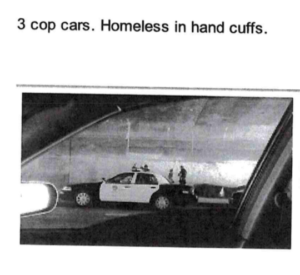
- On the Internet Archive — As usual, this has the advantage that you can get the whole batch via BitTorrent if that’s useful. By later today, also, there should be OCRed PDFs there, and text versions.
- From our local server
Also, I added a few new terms to our glossary to help you read the emails, which are decidedly acronym heavy.2 These are CES, CSI, HE, PATH, and M&O. You can see the new definitions after the break (as well, of course, as via the menu structure or on the page itself). After the break I also discuss some fragmentary information about the City’s so-called Encampment Cleanup Authorization System.3
New glossary entries:
- CES — Coordinated Entry System. This is an attempt to register homeless people for various purposes. You can read what CityWatch thinks of it here
- CSI — Clean Streets Initiative. A program created by an Executive Directive published by Garcetti. Here is what the City says it is. Here is Garcetti’s press release about it. Note that none of those documents mention homelessness. In practice this is the program under which LA Sanitation cleans out homeless encampments.
- HE — Homeless Encampment.
- M&O — Maintenance and Outreach.
- Maintenance and Outreach — (Also known as M&O)This is one stage in the City’s new (2016) procedure for dealing with homeless encampments. I’m not sure yet of exactly what it entails or where it fits into the process. Evidently it is required before Sanitation and the LAPD actually break up the encampment.
- PATH — People Assisting the Homeless is a nonprofit that contracts with some City agencies to provide outreach to people living in encampments prior to LA Sanitation cleaning them up. This seems to be part of the City’s probably-futile effort to make it look like they’re breaking up these encampments in accordance with the rule of law.

This bill would require each local agency, except a local educational agency, in implementing the California Public Records Act, to create a catalog of enterprise systems, as defined, to make the catalog publicly available upon request in the office of the person or officer designated by the agency’s legislative body, and to post the catalog on the local agency’s Internet Web site
Amazingly enough, the City of Los Angeles has complied with this requirement,5 and you can see their listing here. One of the options they offer there is to download the whole thing in CSV format. This can easily be turned into an Excel spreadsheet, which I did, and here is a copy of that if you want it.6
One of the items in the spreadsheet is the “Encampment Cleanup Authorization System,” which “Creates and tracks requests from City officials for encampment cleanups.” I have requests in with LA Sanitation to get information out of this system, and I’ll report on that when (and if) it shows up. Meanwhile, though, one of the emails I published today has a number of records from the system included in it, which is really a lucky stroke. The quality of these is abysmal, since CD13 printed them out on paper,7 it was purple paper,8 I scanned them with my own scanner,9 and the quality was degraded at each step. But these are the first instances I’ve seen of this material, so it’s important! I’ve separated them out for convenience, and here is a list:
- 2015-00991 Encampment Online Authorization
- 2016-00331 Encampment Online Authorization
- 2016-00460 Encampment Online Authorization
- Spreadsheet summary output from the system
There’s a lot of information about the encampment cleaning system to be gleaned just from the fields on these documents. Also, there’s a lot of information in the email chain they came from with respect to the fact that clean-up authorizations expire and have to be renewed, who requests cleanups, how far in advance they’re in the system, how long it takes from report to clean-up, and so on. There are mostly not definitive answers to these questions, but there are clues. I don’t have time today to analyze this, but I wanted to get the information out.
Image of cop car is a public record. Image of Hertzberg is freely licensed according to Wikipedia (not Wikimedia this time, for some reason I don’t have time to sort out).
- Some of these revealed the story of the infamous but respectful Bryan Kim, and I think that the sheer weirdness of that whole story distracted me from the more mundane but decidedly more important other information to be gleaned from these emails.
- Tangentially, I wonder if there’s any correlation between the intensity of bureaucratic acronym and euphemism use and the perceived level of public outrage that would result from the exposure of the activities of the bureaucrats. As with many such matters, the Platonic ideal is provided by the Nazi (itself an acronym, and a euphemism, for that matter) regime. One particularly surreal example, although of course it’s hard to choose, is found in the Kraft durch Freude program, a euphemism with an acronym: KdF This program, amongst other strange, slightly spooky, things, gave the world the Kraft-durch-Freude-Wagen, AKA the KdF-Wagen. Not that they were ashamed of their car design programs, but their acronym/euphemism use was astonishingly ubiquitous. This is just one instance.
- Some of the content of these emails is of independent interest and I’ll try to get to at least one example in the next day or two, but in this post I’m focusing just on what they tell us about the City’s process.
- This story will come back around to homeless encampment cleanups, I promise. But one of this blog’s main subjects is CPRA geekery, and this is a prime example, so I’m including lots of detail.
- Although they didn’t do it by the statutory deadline, which was July 1, 2016. If you have some spare time and you want to hassle some BIDs, it seems that none of them are in compliance with this new law other than the Downtown Center BID, which came into compliance probably only in response to my obsessive wheedling. Not that there’s anything wrong with that.
- Because CPRA requires agencies to run queries against databases and provide the results as public records, you might look on this list of computer applications as a catalog of new stuff to make requests about. I do see it that way, and I have already gotten information from the City Clerk the existence of which I wouldn’t even have suspected had it not been for this new law. I will probably publish some of that at some point, although it’s not necessarily especially revelatory. Irrespective of that it definitely shows how useful this list, and therefore Hertzberg’s law, will be.
- In violation of CPRA.
- God only knows why.
- Because the City of LA charges $0.10 per page to make copies, even though CPRA only allows them to charge that for copies of documents which they actually hold on paper, as opposed to documents that they unilaterally and illegally decide to print onto paper, seemingly solely so that they can charge for copies. For some reason some City agencies allow the use of personal scanners. At this point, CD13 is so obstructionist with respect to my CPRA requests that I can’t imagine they have any other reason for continuing to allow me to use my own scanner than that if they stopped now it would make them look even more guilty of retaliation than they already do. If that’s indeed what’s going on, it’s certainly not going to save them once the investigation starts. Just saying…
